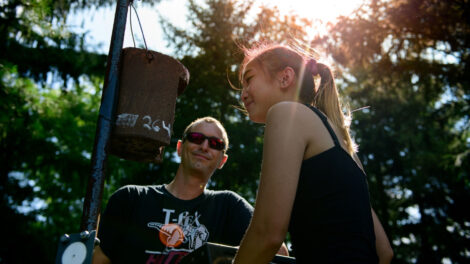Professor, student, and alums explain how moving animal groups change shape over time
Ever watch as a flock of birds flies around a field in a haphazard way, only to decide in an instant to all fly away to a different location?
Assistant professor Daniel Strömbom and Grace Tulevech ’22 sought to find out how. With the help of Zachary Cullen ’22 and Rachel Giunta ’23, they were able to find an answer through projects in the course Collective Phenomena in Animal Groups BIOL 357.

Rachel Giunta ’23 presented findings during a Lafayette poster session this fall.
They found that the size of the field of view each individual in the group has (0 to 360 degrees) dictates when and how the group as a whole can make switches back and forth between different group types, Strömbom says.
“Through previous work we had learned that the textbook explanation for how moving animal groups function can explain switches and other disruptive phenomena too, but not how or why that is, which limited the value of this knowledge,” Strömbom says. “So, we set out to find the precise mechanism(s) that govern this capacity, and by combining work by Grace, Zach, Rachel, and myself, we were able to establish that the asymmetric interactions that result from a restricted field of view in each individual are responsible for this capacity.”
Their findings,“Asymmetric interactions induce bistability and switching behavior in models of collective motion,” were published in the peer-reviewed journal Dynamics in December 2022. Giunta also presented their research during a poster session at Lafayette this fall.
“It has been a great experience doing research with Professor Strömbom,” Giunta says. “I have learned so much about collective motion as a discipline, but also the research process in general. I am grateful that I have had the opportunity to do this research and look forward to continuing our work this semester.”
The work built upon previous research published earlier in 2022 by Lafayette students Stephanie Nickerson ’17, Cat Futterman ’20, Cameron Costello ’20, and Alyssa DiFazio ’21 and Strömbom that settled the long-standing question of whether the current textbook answer for how flocks, schools, and herds form and function also can be used to explain the spontaneous structural changes observed in, effectively, all real moving animal groups.

